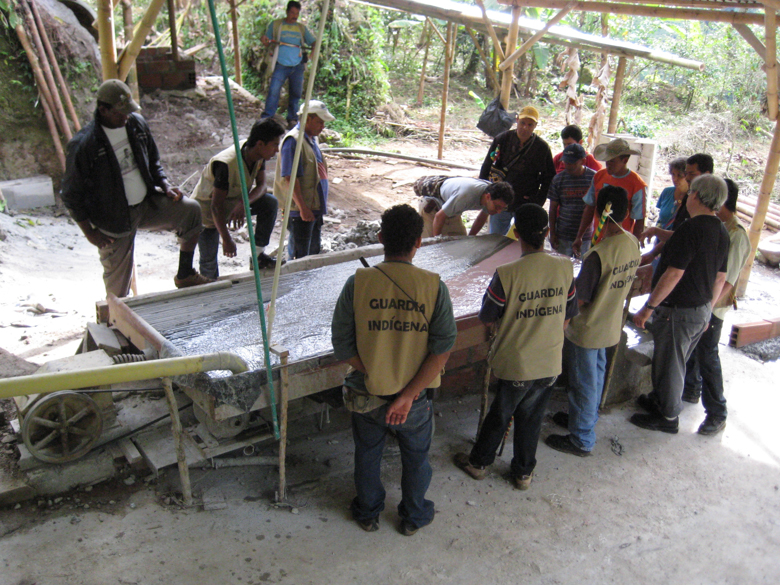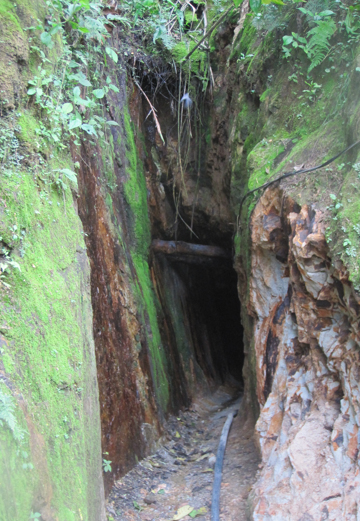- Fernando Salazar Calvo, an active member and spokesperson of an association of artisanal indigenous miners in Colombia’s Cañamomo Lomaprieta Indigenous Reservation, was murdered on April 7.
- The association and other indigenous leaders have been fighting to prevent destructive mining by companies and illegal armed groups on the reservation.
- No one has been arrested in connection with Salazar Calvo’s murder.
Indigenous small-scale miners and traditional authorities in western Colombia are facing threats in the wake of a local leader’s murder this spring.
On April 7, 2015, Fernando Salazar Calvo was fatally shot by an unknown assailant outside his home. He was an active member and spokesperson of the Association of Artisanal Miners of the Cañamomo Lomaprieta Indigenous Reservation (ASOMICARS). No one has been arrested in connection with Salazar Calvo’s murder.
Two hundred and thirty miles west of Bogotá, the reservation overlaps with the municipalities of Ríosucio and Supía in the Caldas department. Governed by a body of indigenous authorities known as a cabildo, the 18.8-square-mile collective territory is home to 23,000 people in 32 communities. It is one of more than 20 resguardos, or reservations, belonging to the Embera Chamí indigenous people, who are among the country’s more than 100 indigenous groups. Farming is the main economic activity in the reservation, but for some locals, artisanal mining is another important subsistence activity going back more than 500 years.

Local Embera Chamí and ASOMICARS leaders have worked for years to regulate indigenous-controlled small-scale mining on the Cañamomo Lomaprieta Indigenous Reservation, and their work is seen as a model by other indigenous and Afro-descendant communities. As in many other resource-rich areas in the country, the reservation is under threat from external actors. These include illegal armed groups and mining companies interested in the reservation’s substantial gold reserves, and ASOMICARS and the Embera Chamí leadership have been struggling to maintain control of outside mining operations.
On the day of Salazar Calvo’s murder, he and ASOMICARS president Fabio Moreno spent most of the day together attending meetings and a community visit. In the preceding two weeks, both men had been threatened by unknown men and told to cease their involvement with indigenous-controlled mining in the area. Four hours after the two parted ways, Salazar Calvo was killed. Moreno said he heard the news when he got home.
“It’s hard right now,” Moreno told mongabay.com in a telephone interview. He has been in hiding for nearly four months since the night of Salazar Calvo’s murder. He has seen his family only in passing and has been advised not to go home anytime soon for his own safety. “Everyone is scared,” he said.
Who can mine indigenous land?
Indigenous resguardos in Colombia are somewhat analogous to reservations in the United States. Created under colonial rule, resguardos isolated indigenous peoples in fractions of their ancestral territories, leaving the remaining lands open for colonization and resource extraction. Nevertheless, in many cases, the territories became strongholds for traditional indigenous authorities and self-governance.

The Colombian Constitution of 1991 recognizes cabildos and the rights of indigenous authorities to exercise jurisdiction in their territories according to customary norms and procedures. The Constitution also establishes that indigenous authorities are responsible for designing economic and social development policies, and plans for protecting natural resources in their territories. Authorities in the Cañamomo Lomaprieta Indigenous Reservation have made significant progress in this respect, developing a regulatory framework for the small-scale mining activities of residents.
In practice, however, Embera Chamí leaders like Moreno are being targeted because of their involvement in control of mining in the Cañamomo Lomaprieta Indigenous Reservation, according to them and to environmental and human rights organizations, and not much is being done to prevent further bloodshed.
“They gave me a bullet-proof vest and a telephone. That’s the precautionary measure they gave,” said Moreno. He was given the items by the government following Salazar Calvo’s murder, but has had no news of any progress in the investigations into the killing, threats, or reports of armed groups entering the reservation territory.
Despite widespread fear, ASOMICARS and Embera Chamí authorities continue to monitor local mining activities in their jurisdiction. “The [indigenous] guard continues to provide accompaniment. When we’re going to do monitoring, we always send guards. If yesterday we sent two or three, today we’ll have 10,” said Moreno.

The Embera Chamí engaged in artisanal gold mining before Europeans arrived to the continent and long before the Colombian state was established. Small-scale mining in the Cañamomo Lomaprieta Indigenous Reservation is now regulated by indigenous authorities, who have also developed protocols and regulations requiring the consultation and consent of the local population for any third-party activities in the collective territory.

Small-scale artisanal mining is subject to a host of restrictions and regulations concerning who can mine, how, where, and how much. Environmental management and mine closure plans are required, and labor and environmental standards protect people, lands, and water sources.
“The use of mercury, cyanide or any other poisonous chemical substance in the processing of gold that endangers human health or the processes of nature that exist within the territory is prohibited,” according to Article 33 of the July 17, 2011 resolution regulating mining in the Cañamomo Lomaprieta Indigenous Reservation.
In another resolution the following year, on March 13, 2012, the traditional Embera Chamí authorities declared the territory off limits to all medium- and large-scale mining. In the decade leading up to the resolution, the Colombian government unilaterally granted mining concessions in Embera Chamí territory. Multinational mining companies such as South-Africa-based AngloGold Ashanti expressed interest in and carried out exploration activities in the area, including within the reservation. Despite the resolution, mining concessions still overlap with reservation lands. The Colombian government does not recognize indigenous ownership or control of subsoil resources.
“Just by issuing concessions, already there’s a whole bunch of violations to the resguardo’s human rights, because issuing concessions under national and international law should be done with the consultation and consent of the Embera Chamí, which hasn’t been done in the case of the resguardo or any other areas, for that matter, in Colombia,” Viviane Weitzner told mongabay.com. A policy advisor with Forest Peoples Programme, a UK-based group advocating for the rights of forest-based communities, Weitzner is currently working with Embera Chamí and other indigenous and Afro-descendant artisanal miners in Colombia.

“The result is a situation where there’s escalation of conflict because you have companies or individuals to whom these concessions are issued who feel that it’s their right now to be able to explore within the territory,” she said.
The Colombian state and the Embera Chamí have very different positions with regards to who owns the subsoil resources, said Weitzner. “There’s a constant tension between the state and its policies with regards to decision-making about resources in the resguardo, and then the resguardo themselves who very much feel that they are the rightful people to have a say in what happens with the resources in their own territories.”
Undermining self-determination
The Colombian state and mining companies are not the only external actors interested in the mineral riches of the Cañamomo Lomaprieta Indigenous Reservation. “The area has been affected by paramilitary groups and bandas criminales [criminal gangs] who sort of go in and out of the territory to make their presence known and who might be behind some of these threats that leaders are receiving right now,” said Weitzner.
A 2014 study by the Colombian government’s Office of the Ombudsman found that “criminal gangs” — illegal armed actors, sometimes with ties to paramilitary organizations and drug trafficking — were operating in 15 percent of the country’s municipalities, and in 27 of its 32 departments.
Also in 2014, as part of its early warning system for potential human rights violations, the Office of the Ombudsman issued a detailed alert about the risks faced by leaders in Embera Chamí territories. Paramilitary activity in neighboring departments “is spilling over into the municipalities of Riosucio and Supía as an important strategic zone for the development of activities such as extortion, the control of informal mining, the dispute for control of drug trafficking routes that cross western Caldas,” according to the alert.
“So there’s both illegal armed groups and companies who see the resources in the resguardo as important to fuel their activities, whether it’s for the benefit of shareholders in the case of companies who are trying to sell off a good prospect to a major company or in the case of illegal armed actors, to launder their money and fuel their activities,” said Weitzner.
Sorting out the different nebulous actors with an interest in mineral resources is a challenge, as they are often inter-connected. There are documented cases of mining companies providing financial and logistical support for right-wing paramilitary groups to protect company interests in Colombia.

In the Cañamomo Lomaprieta Indigenous Reservation, what’s at stake is the self-determination of the people, according to Weitzner. “There’s a variety of different threats that are putting pressure on the resguardo and the Embera Chamí people. Primarily, I think the fact that they are self-governing peoples implementing their own policies and their own rules and regulations around the minerals that are embedded in their territories seems to be a threat to several different parties,” she said.
The pressure has been constant since Salazar Calvo’s murder in April. “There is impunity right now. We don’t know who killed Fernando Salazar and we feel that there isn’t enough effort being put in place to make sure there’s rigorous investigation so that this doesn’t happen again,” said Weitzner.
Contacted for this story, the Office of the Ombudsman did not provide details about the investigation into Salazar Calvo’s murder and the ongoing threats faced by other local leaders. The state agency is currently working on a follow-up report to the 2014 early warning system alert as per procedure, an official working with the Office of the Ombudsman’s regional office in Caldas wrote in an email to mongabay.com. “The information that the Office of the Ombudsman has to date is confidential,” according to the official.
Unless something changes, Fabio Moreno is unable to return home for safety reasons. Nevertheless, he is continuing his work as president of ASOMICARS at great risk in order to protect the collective Embera Chamí lands and resources, he said. Moreno said he can’t be sure who is responsible for the murder of Salazar Calvo and for the threats he and others have received, but he is sure about the motive. Whether it is paramilitary groups or criminal gangs or mining companies that are behind the violence, interest in the reservation’s mineral resources is likely the motive, he said.
“What these people want is for the processes to fall apart, for the organization not to have any intervention in the issue of mining…so that the companies can come in,” he said.
